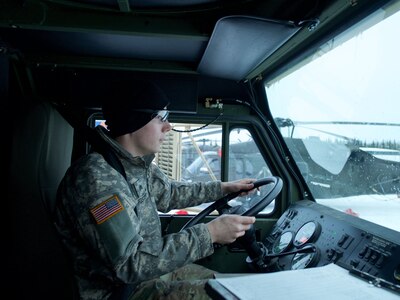By Army Sgt. David Bedard, 134th Public Affairs Detachment
JOINT BASE ELMENDORF-RICHARDSON, Alaska, Dec. 18, 2017 —
Alaska Army National Guard Sgt. Cody Foster’s time at Basic Combat Training at
Fort Jackson, South Carolina, was his first trip to anywhere outside of Alaska.
To fight the unfamiliar stifling heat and humidity, the
Kenai native did what the drill sergeants told him to do: he drank lots of
water.
Because he succeeded at Fort Jackson, and later during
advanced individual training at Fort Lee, Virginia, the petroleum supply
specialist with Echo Company, 1st Battalion, 207th Aviation Regiment, said he
learned the value of following instructions in the Army.
When it comes to safely pumping fuel into 1st Battalion,
207th Aviation Regiment, UH-60 Black Hawk helicopters, following instructions
to the letter is critical to the job, Foster said.
Foster dispenses the fuel from an eight-wheel-drive Heavy
Expanded Mobility Tactical Truck tanker parked close to the flight line at Bryant
Army Airfield here.
Training to Fight
During the unit's drill this month, Foster partnered with
fellow petroleum supply specialist Spc. Jesse Gray to top off a UH-60 following
a sortie. The duo scrambled to the cab of their HEMTT fueler and drove a few
hundred yards to the helicopter.
The soldiers’ uniforms are different than their ground unit
counterparts. They wear a special fire-retardant jacket for obvious reasons;
they don fuel-proof gloves to ensure any fuel spilled on them in subzero weather
doesn't instantly cover their hands with frostbite. And eye and hearing
protection are always a must.
For a "cold" refuel, the Black Hawk is tied down
and has ground wires staked into grounding points. Foster and Gray also
grounded the HEMTT, to ensure a spark wouldn't ignite the volatile JP-8 fuel
onboard.
"Any and all static that comes from the hose, the line
and the aircraft all goes straight to ground and stops us from having a
[mishap]," Foster said.
Foster and Gray worked with the deliberate speed and precise
attention to detail of a NASCAR pit crew.
Foster paid out the refueling hose from a spool on the back
of the HEMTT before hooking up to the idle UH-60. Gray controlled a valve at
the truck end, giving him the ability to cut fuel flow if he identified an
emerging hazard.
The operation was quick, limited in speed primarily by the
time it takes to fill the fuel tanks of the helicopter. Rapid as it is,
refueling is merely the culmination of Foster's efforts.
Testing, Safety
Before he can fill up a whirlybird and send it back into
action, Foster has to get the fuel. He said he requisitions the JP-8 from the
Air Force fuel farm on the base. The fuel is then stored in large tanks
operated locally by the battalion.
Before the fuel is certified for use, Foster tests it for
contaminants and water content.
"Every time we receive fuel, we need to do a sample on
each tank to make sure the fuel we have is good," he said. "It's
never come up bad, but it's just an extra precaution."
As layered and nuanced as refueling helicopters on an active
airfield is, Foster is ready to do the same mission in austere conditions in a
combat zone.
Foster's company is equipped and trained to establish an
ad-hoc logistics operation, called a forward arming and refueling point, on an
improvised airfield.
Without Bryant Air Field's hardstand helicopter parking
spots with their pre-positioned tie-down and grounding points, Foster said he
relies on the equipment in his tanker to ground the helicopter in the field.
Besides eating field rations, skipping a few showers and
living out of a duffel bag, the job changes little in a field environment,
Foster said. Even during a "hot" refuel -- when the helicopter is
running and often flies away after topping off -- the fundamentals of grounding
the aircraft and maintaining safety stay the same, Foster said.
Role Model
Army Sgt. Zachary Adams, a squad leader in Echo Company,
said Foster serves as a good role model for other soldiers in the unit. Adams
said Foster takes pride in his work and is known for his reliability and
accountability to the standards of the job.
"He really takes the time to ensure he and other
soldiers take the time to do the job safely," Adams said.
Foster said he relishes staying busy.
"My favorite part of this job is we always have a
mission," he said. "Those birds need to fly. Pilots always need
flight time.
"There's always something to do here," Foster
continued. "It requires the same amount of brainwork as it does physical
activity. It's never boring."







No comments:
Post a Comment